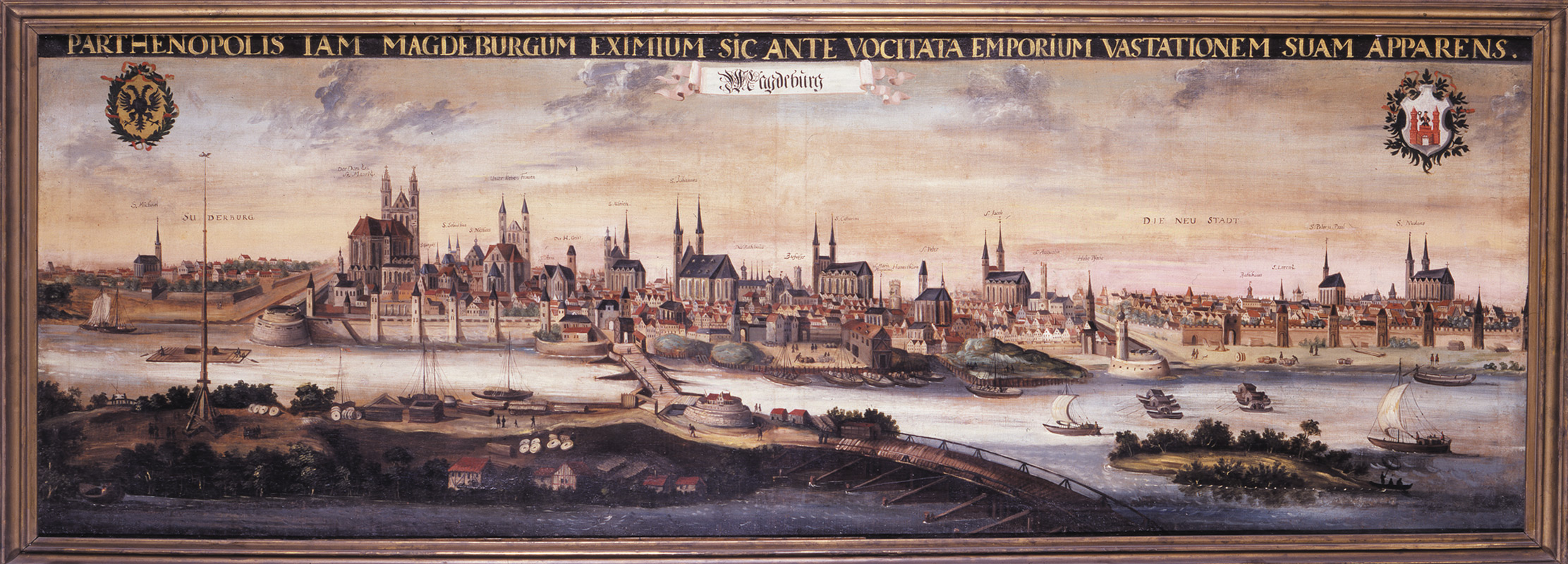The history of the present-day capital of the state of Saxony-Anhalt began in the Carolingian era. The first mention of Magdeburg dates to 805, appearing as Magadoburg in Charlemagne’s Capitulary of Diedenhofen. At that time, Magdeburg was a center of long-distance trade and an outpost to the Slavic territories east of the Elbe.

Magdeburg before its destruction in 1631, after an etching by Jan van de Velde (Photo: Kulturhistorisches Museum Magdeburg)
A sustained boom occurred in the era of the Ottonian dynasty. Magdeburg became one of the most important centers of the empire under the later Emperor Otto the Great (reigned 936−973). In 929, he chose Magdeburg as his morning gift for his first wife Eadgyth. The fortified city initially served as a base against the subjugated Slavic territories east of the Elbe. Archeological finds of ecclesiastical structures from this period reveal the city’s imperial and sacral significance for the Ottonians. It was no accident that Emperor Otto the Great eventually selected the Magdeburg Cathedral as the final resting place for his wife Eadgyth and himself.
Magdeburg also played a special role in missionizing the Slavic territories that had not been fully subjugated yet. With the pope’s approbation, Otto the Great established an episcopal see in Magdeburg, which influenced the city’s fortunes significantly in the centuries that followed. The Slav rebellion in 983 disrupted the episcopal see’s further development for a time. Under the Salians, the city eventually lost its central role in the empire and the Duchy of Saxony until Archbishop Norbert of Xanten’s labors restored the episcopal see and thus the city as well to certain prominence within the movement to reform the church.
The toll, commercial and travel privileges granted to Magdeburg’s merchants by Otto I and Otto II (reigned 973−983) are particularly significant to the city’s history. Thietmar of Merseburg furnishes an account of the beginnings of an independent merchant colony. Written sources from the early 12th century onward refer to the residents of the city as burghers rather than merchants. The emerging urban upper class increasingly gained control over municipal jurisdiction, particularly through the lay judges who assisted the magistrates appointed by the territorial burgrave and are documented for the first time in 1129. Steadily evolving dynamically and regarded as extremely beneficial and innovative outside of Magdeburg, Magdeburg‘s municipal law began spreading around 1160. The epitome of German municipal law,
it was subsequently adopted in large parts of Eastern Europe and eventually established one of the most significant networks of municipal law in European history.
The development of the city itself was continually accompanied by conflicts between municipal and territorial authorities in the ensuing centuries. Even though Magdeburg never achieved the status of imperial immediacy, its residents succeeded in progressively acquiring high jurisdiction in issues of municipal governance, administration of justice and lawmaking through such institutions as the tribunal of lay judges and, from 1244 onward, the city council as well. The further development of these institutions and the refinement of the municipal law were likewise dominated by ongoing disputes over jurisdiction. The city council, initially a committee of lay judges that governed the city, took over the tasks of government entirely in 1293−94 and progressively gained influence over municipal jurisdiction in the ensuing period. The tribunal of lay judges, on the other hand, lost its significance in the city and increasingly became confined to issuing legal opinions from the lay judges’ bench. At the same time, it gained importance as a tribunal advising other cities in legal matters and thus strengthened its role as the tribunal of Magdeburg law.
The city’s ongoing conflicts with its territorial lords, the archbishops, culminated in an armed conflict, which reached its height with the murder of the then-archbishop in 1325. The city and its citizens were only able to free themselves from the ensuing ban by making major concessions. Although the archbishop eventually asserted his overlordship of the city at the close of the 15th century, the lay judges’ bench and thus the city nevertheless initially retained their central role in the cities with Magdeburg law.
Another significant caesura in Magdeburg’s history was its residents’ conversion to Lutheranism, culminating in a siege and virtually complete destruction of the city by imperial troops during the Thirty Years’ War. This was accompanied by the destruction of the archive of Magdeburg’s lay judges’ bench. The progressive emergence of nation states and the reception of academic Roman law eventually brought an end to the central function of Magdeburg’s lay judges’ bench as an advisory body for numerous Eastern European cities with Magdeburg law.
Thereafter, the city’s history was primarily dominated by the transformation of the prince-archbishopric Magdeburg into a hereditary and secular duchy after the Peace of Westphalia in 1648 and its status as a Prussian citadel, which severely curtailed the city’s development and growth until its status as a citadel was rescinded in 1900.
Literature:
Magdeburg. Die Geschichte der Stadt 805-2005. Ed. by Matthias Puhle, Peter Petsch. Dössel 2005.
Berent Schwineköper: Art. “Magdeburg”, in: HRG 3 (1984), Col. 129 ff.
